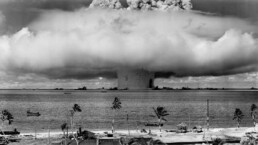Hundreds of Cold War-era nuclear tests have left a trail of death across the country.
by Mary Dickson, The Progressive
As Christopher Nolan’s Oppenheimer painstakingly demonstrates, after witnessing the first detonation of a nuclear weapon, J. Robert Oppenheimer, knew the destructive force he had helped to unleash with the Trinity Test in 1945. Almost eighty years later, Americans and people across the globe are still living with the devastating consequences.
The film has been criticized for not including what came after Trinity, but fortunately it is generating a long overdue dialogue about the test’s aftermath—not just the arms race it triggered, but the millions of innocent people around the world, including my family and I, whose lives have been shattered by nuclear weapons production and testing.

As audiences leave theaters, I want them to think about this: the explosion at Trinity was only the first nuclear bomb detonated on American soil. From 1951 to 1992 during the Cold War, the United States detonated 928 nuclear bombs in the deserts of Nevada, just sixty-five miles from Las Vegas. Hundreds were many times more powerful than those that leveled Hiroshima and 100 were detonated in the open air, spreading radioactive fallout across the entire nation and beyond. The Atomic Energy Commission (AEC) knew when it moved testing to Nevada that the prevailing winds in the United States would blow eastward and carry fallout with them, but it went ahead with testing there anyway. They hid the truth from the public for decades opting instead for the “judicious handling of public information.” The landmark federal case Allen v. United States concluded in 1984 that the government’s negligence harmed and killed its own citizens.
Recent Posts
‘Unconstitutional. Unethical. Authoritarian.’ ICE Bars Millions Of Immigrants From Bond Hearings
July 18, 2025
Take Action Now One watchdog said the new policy “seems like a blatant attempt to stop them from exercising their right to due process.”……
Americans Are Not Nearly Alarmed Enough About Climate Change
July 18, 2025
Take Action Now Americans still don’t comprehend how imminent, dangerous, and far-reaching the threat is—and journalists are partly to blame.By…
The IRS Is Building A Vast System To Share Millions Of Taxpayers’ Data With ICE
July 17, 2025
Take Action Now ProPublica has obtained the blueprint for the Trump administration’s unprecedented plan to turn over IRS records to Homeland Security…
Israel’s Sudden Assault On Syria Is Unchecked Aggression
July 17, 2025
Take Action Now Jerusalem is bombing Damascus and threatening al-Sharaa’s rule, while Washington was hoping to help the nascent government on…




